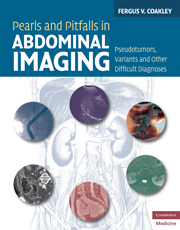Book contents
- Frontmatter
- Contents
- Preface
- Acknowledgements
- Section 1 Diaphragm and adjacent structures
- Section 2 Liver
- Case 11 Pseudocirrhosis of treated breast cancer metastases
- Case 12 Pseudocirrhosis of fulminant hepatic failure
- Case 13 Nutmeg liver
- Case 14 Nodular regenerative hyperplasia
- Case 15 Pseudoprogression of treated hepatic metastases
- Case 16 Pseudothrombosis of the portal vein
- Case 17 Biliary hamartomas
- Case 18 Nodular focal fatty infiltration of the liver
- Case 19 Nodular focal fatty sparing of the liver
- Case 20 Hepatocellular carcinoma mimicking focal nodular hyperplasia
- Case 21 Paradoxical signal gain in the liver
- Section 3 Biliary system
- Section 4 Spleen
- Section 5 Pancreas
- Section 6 Adrenal glands
- Section 7 Kidneys
- Section 8 Retroperitoneum
- Section 9 Gastrointestinal tract
- Section 10 Peritoneal cavity
- Section 11 Ovaries
- Section 12 Uterus and vagina
- Section 13 Bladder
- Section 14 Pelvic soft tissues
- Section 15 Groin
- Section 16 Bone
- Index
- References
Case 14 - Nodular regenerative hyperplasia
from Section 2 - Liver
Published online by Cambridge University Press: 05 November 2011
- Frontmatter
- Contents
- Preface
- Acknowledgements
- Section 1 Diaphragm and adjacent structures
- Section 2 Liver
- Case 11 Pseudocirrhosis of treated breast cancer metastases
- Case 12 Pseudocirrhosis of fulminant hepatic failure
- Case 13 Nutmeg liver
- Case 14 Nodular regenerative hyperplasia
- Case 15 Pseudoprogression of treated hepatic metastases
- Case 16 Pseudothrombosis of the portal vein
- Case 17 Biliary hamartomas
- Case 18 Nodular focal fatty infiltration of the liver
- Case 19 Nodular focal fatty sparing of the liver
- Case 20 Hepatocellular carcinoma mimicking focal nodular hyperplasia
- Case 21 Paradoxical signal gain in the liver
- Section 3 Biliary system
- Section 4 Spleen
- Section 5 Pancreas
- Section 6 Adrenal glands
- Section 7 Kidneys
- Section 8 Retroperitoneum
- Section 9 Gastrointestinal tract
- Section 10 Peritoneal cavity
- Section 11 Ovaries
- Section 12 Uterus and vagina
- Section 13 Bladder
- Section 14 Pelvic soft tissues
- Section 15 Groin
- Section 16 Bone
- Index
- References
Summary
Imaging description
Nodular regenerative hyperplasia is an increasingly recognized condition characterized by transformation of normal liver parenchyma into hyperplastic regenerative nodules in the absence of fibrosis (the absence of fibrosis distinguishes nodular regenerative hyperplasia from cirrhosis) [1,2]. The condition has been reported in up to 3% of unselected patients at autopsy [3]. From a radiological perspective, there appear to be two forms of the condition: a diffuse form in which the nodules are small and widespread, and a focal form in which the nodules are few in number, scattered throughout the liver, and measure up to a few centimeters in size. In the diffuse form, imaging findings can be subtle across all modalities [2, 4, 5]. At US, multiple masses that are hypo-, iso-, or hyperechoic may be seen (Figure 14.1). AT CT the lesions are usually hypodense with little enhancement. At MRI, nodular regenerative hyperplasia is usually of similar signal intensity to the liver on T1, T2, and post-gadolinium sequences. While the literature on this topic is limited, it seems the nodules may be more obvious on ultrasound than CT or MRI [4], and this has been my experience (Figures 14.1 and 14.2). A periportal distribution has been described [3]. In the focal form of nodular regenerative hyperplasia, multiple hypervascular masses are seen at CT or MRI (Figure 14.3).
- Type
- Chapter
- Information
- Pearls and Pitfalls in Abdominal ImagingPseudotumors, Variants and Other Difficult Diagnoses, pp. 40 - 43Publisher: Cambridge University PressPrint publication year: 2010

